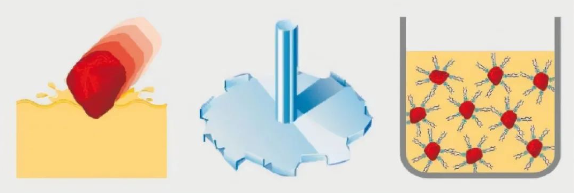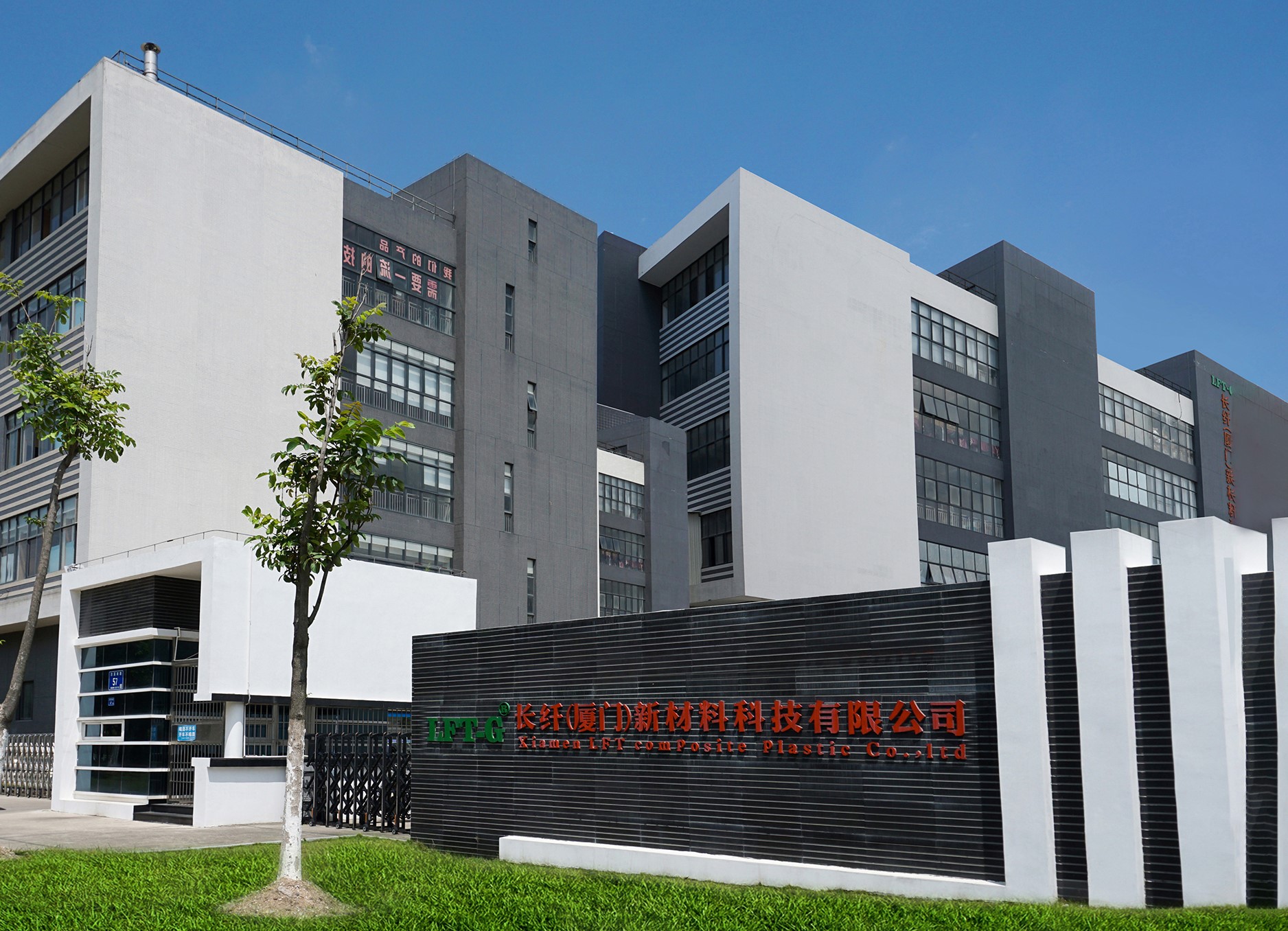수정원리
변성 플라스틱이란 일반 플라스틱과 엔지니어링 플라스틱을 기본으로 충전, 혼합, 강화 등의 방법을 통해 난연성, 강도, 내충격성, 인성 등의 특성을 향상시키기 위해 가공, 변성한 플라스틱을 말한다. 변형에는 플라스틱의 첨가, 변형된 플라스틱에 충전재가 분산된 상태 및 형성이 포함됩니다. 콘크리트에 모래와 자갈을 추가하는 것처럼 충전재도 수지 인터페이스 구조에 큰 영향을 미칩니다. 충전재의 분산에 대해서는 다음과 같습니다.
분산상태
1. 고분자 용융물에 무기입자를 첨가하면 무기입자의 분산미세구조가 3가지로 나타날 수 있다. â 두 번째 집합 상태인 이 분산 상태는 좋은 향상 효과를 갖습니다. (2) 불규칙한 분산 상태로 일부는 그룹으로 모여 있고 일부는 개별 분산 형태로 존재합니다. 이 분산은 강화되거나 강화되지 않습니다. • 매트릭스 수지에 균일하게 분산됩니다. 이 경우 입자와 매트릭스 수지 사이에 좋은 계면이 있는지 여부에 따라 특정 강화 및 강인화 효과가 있을 것입니다. 강화되고 강화된 충진재 개질 플라스틱을 얻기 위해서는 3차 분산 상태가 가능할 것으로 기대된다.

침지, 교반, 분산 공정
2. 무기분말 입상 충진재가 매트릭스 수지에 개별적으로 균일하게 분산될 수 있는지 여부는 다양한 요인과 관련이 있다. 고정된 가공 조건의 경우 충진 개질의 예상 효과에서 무기 입자 크기가 작을수록 좋습니다. 그러나 크기가 작을수록 표면에너지가 높을수록 자기응고력이 강해 균일하게 분산되기가 어렵습니다. "응집" 효과는 고속 운동의 충돌과 마찰로 인해 발생하는 표면 에너지와 정전기에 의해 형성됩니다. 이러한 종류의 응축수는 후속 혼합 및 성형 공정에서 기계적 전단력에 의해 더 이상 열리지 않으며, 변형 플라스틱에서 "백색 반점"이 가장 잘 보이지 않는 2차 불규칙 분산 상태를 나타냅니다.
포장된 상태
분말입상이란 장경비가 대략 1인 충진재가 분산된 상태를 말하며, 상대적으로 길이직경이 큰 충진재는 짧은 섬유상, 침상, 얇은 시트상의 충진재를 말한다. 섬유질 재료는 강화 효과가 좋지만 대부분의 섬유질 충전재는 가격이 비싸고 환경 보호가 좋지 않습니다. 탄산칼슘 섬유(휘스커)의 대량생산은 이러한 상황을 변화시킬 수 있으며, 긴 길이의 위스커는 제지산업용 제지섬유를 감소시킬 수도 있다.
수정된 신청서
우수한 비용 성능으로 변성 플라스틱은 점점 더 많은 하류 분야에 적용되고 있습니다. 개질 플라스틱이 소비 트렌드로 자리 잡았다고 할 수 있는데, 이러한 트렌드의 이면에는 다음과 같은 5가지 요인이 함축되어 있습니다.
고성능: 변성 플라스틱은 저밀도 및 내식성과 같은 기존 플라스틱의 장점을 가질 뿐만 아니라 고강도, 고인성, 고충격성, 내마모성 및 내진성과 같은 우수한 물리적, 기계적 특성도 가지고 있습니다. 또한, 플라스틱의 종합적인 성능 향상은 다운스트림 분야에 폭넓게 적용할 수 있는 기반을 제공합니다.
저비용: 다른 재료에 비해 플라스틱은 높은 생산 효율성과 낮은 밀도의 장점을 가지며 비용이 저렴합니다. 플라스틱의 단위 부피당 비용은 금속의 10분의 1 정도에 불과합니다.
정부 정책: 중국은 '3C' 강제 인증 제도를 시행하여 카탈로그에 제품의 안전 성능을 엄격하게 규정함으로써 가전제품, IT, 통신 등 분야에 난연성 플라스틱의 폭넓은 적용을 촉진하고 있습니다. 필드.
소비 업그레이드: 생활 수준이 향상됨에 따라 사람들은 더 우수한 제품 성능을 추구하기 시작하여 가전 제품 및 기타 제품에 더 아름답고 안전하며 내구성이 요구되며 업스트림 플라스틱 산업에 대한 더 높은 요구 사항을 제시하여 가공 성능, 기계적 특성, 내구성 및 안전성이 향상됩니다.
기술적 요인: 전 세계적으로 1000종 이상의 폴리머가 발견되었지만 실제 응용 가치가 있는 폴리머는 수십 가지에 불과합니다. 새로운 폴리머를 개발하려면 막대한 투자가 필요할 뿐만 아니라 적용 가능성도 불확실합니다. 이에 반해 개질기술은 기존 폴리머의 특성을 산업계의 요구에 맞게 향상시킬 수 있을 뿐만 아니라 일부 고가의 엔지니어링 플라스틱의 원가를 낮춰 플라스틱 산업을 발전시키는 효과적인 방법이 되고 있다.
경도지수
많은 산업 분야에서 "철을 플라스틱으로 대체"하는 추세가 나타나고 있으며 경도가 주요 지표입니다. 경도는 다른 더 단단한 물체에 의해 표면에 눌려지는 것을 저항하는 재료의 능력을 나타냅니다. 경도를 표시하기 위해 일반적으로 사용되는 몇 가지 방법이 있습니다:
아. 쇼어 경도
나. 로크웰 경도
c, 모스 경도
변성플라스틱 경도첨가란 플라스틱에 경질첨가제를 첨가하는 변성방법을 말한다. 일반적으로 사용되는 경도 충진제는 경질 무기 충진재와 섬유이다.
(1) 경질 무기충진재를 첨가한다
표면처리로 플라스틱의 경도를 향상시킵니다
플라스틱의 표면 경도 향상 방법은 플라스틱 제품의 외부 표면의 경도를 향상시키고 내부 제품의 경도는 그대로 유지하는 것을 말합니다. 이는 저비용의 경도 향상 방법이다.
이 변형 방법은 주로 쉘, 장식 재료, 광학 재료 및 생활 필수품에 사용됩니다. 이러한 개질방법은 주로 코팅, 코팅 및 표면처리를 포함한다.
(2) 블렌딩을 하면 플라스틱의 경도가 향상된다.
플라스틱 블렌딩의 개선된 방법은 고경도 수지와 저경도 수지를 혼합하여 전체적인 경도를 향상시키는 것입니다. 일반적인 블렌드는 PS, PMMA, ABS, MF 등이며, 개질이 필요한 수지는 주로 PE, PA, PTFE, PP입니다.
(3) 복합개량플라스틱의 경도
플라스틱 복합체의 경도를 향상시키는 방법은 경도가 낮은 플라스틱 제품의 표면에 경도의 수지층을 합성하는 것이다. 이 방법은 주로 판, 시트, 필름, 파이프 등의 압출제품에 적합합니다. 일반적으로 사용되는 복합수지는 PS, PMMA, ABS, MF 등이다.

샤먼 LFT 복합 플라스틱 유한회사LFT&LFRT를 전문으로 하는 브랜드 회사입니다. 장유리섬유 시리즈(LGF) 및 장탄소섬유 시리즈(LCF). 이 회사의 열가소성 LFT는 LFT-G 사출성형 및 압출에 사용할 수 있으며, LFT-D 성형에도 사용할 수 있습니다. 고객 요구 사항에 따라 길이 5~25mm로 생산 가능합니다. 회사의 장섬유 연속 침투 강화 열가소성 플라스틱은 ISO9001&16949 시스템 인증을 통과했으며, 제품은 많은 국가 상표와 특허를 획득했습니다.
태그 :